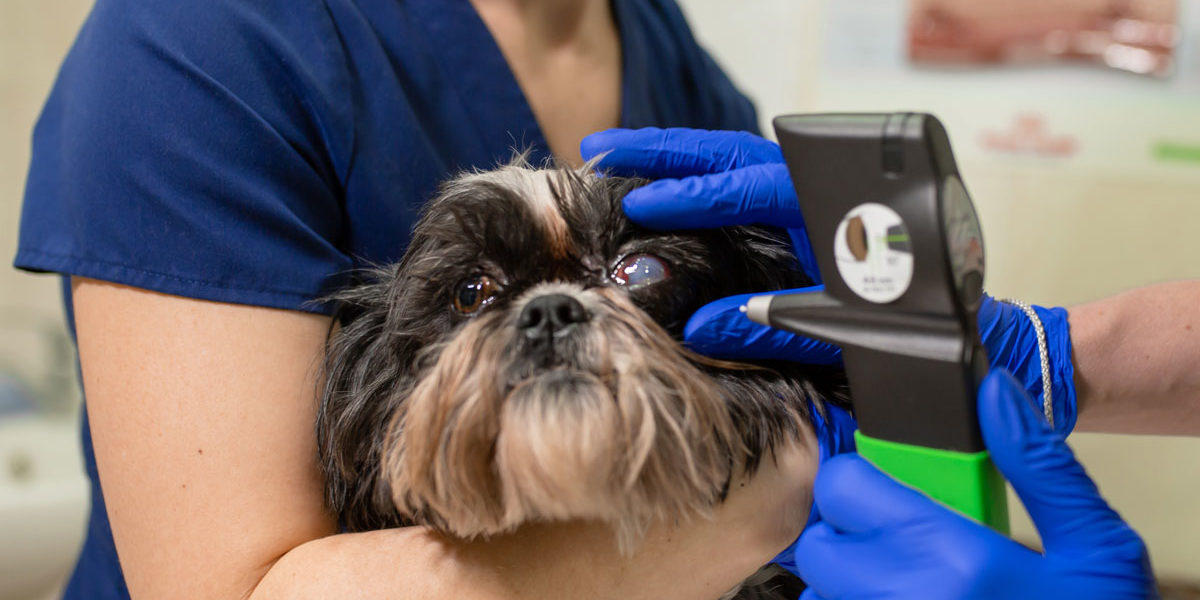By Todd Marlo, DVM, MS, DACVO
Glaucoma is often a frustrating disease for owners, veterinarians, and ophthalmologists. Changes can occur within the eye; vision can be lost quickly and decisive decision making is crucial. This blog post covers the types of glaucoma, medical and surgical options, and emergency treatment.
Types of Glaucoma
Glaucoma presents one of two ways: primary or secondary. Primary deals with a change to the iridocorneal angle that is genetic in etiology. Secondary glaucoma is due to another ocular disease such as an intraocular mass, anterior lens luxation, or uveitis. The key difference is that in primary glaucoma, the contralateral eye is at risk of developing the disease as well. While there are many different breeds known to be at risk for developing primary glaucoma, more well-known breeds include Bassett Hounds, Siberian Huskies, and Cocker Spaniels. Gonioscopy is a technique that ophthalmologists utilize to determine how open or closed the iridocorneal angle is. High resolution ocular ultrasonography can also be used for this purpose. Dogs with a closed or narrow angle are at risk, and therefore prophylactic therapy with either dorzolamide or timolol would be indicated.
Open Angle:
Closed Angle:
Medication Options
A variety of glaucoma medications are available, sometimes leading to confusion on what to prescribe. Medications can be categorized into those that decrease aqueous humor production, those that increase aqueous humor outflow, or those that do both. Aqueous humor production is reduced with dorzolamide and timolol. Outflow is increased with mannitol and pilocarpine. Prostaglandin agonists, such as latanoprost, have both qualities. Dorzolamide, timolol and latanoprost are the most commonly prescribed glaucoma medications. Frequency can range from once daily for controlled cases, to four times daily for patients in an acute glaucomatous crisis.
Non-Medical Options
Should medications fail or not be feasible due to the dog’s behavior, there are other treatment options. These include enucleation, intrascleral prosthesis, or an intravitreal gentamicin injection. The goal for all of these procedures is to restore the animal’s comfort, with the latter two options also being more cosmetically appealing for the owner.
Additionally, there are glaucoma surgeries that can be used in conjunction with medical therapy. These procedures need to be performed by a boarded veterinary ophthalmologist, as they have the necessary equipment, skill, and experience to deal with complications. These include trans-scleral cyclophotocoagulation, goniovalve placement, and endolaser. All of these procedures have varying success rates and costs.
Emergency Therapy
In an acute glaucomatous crisis time is of the essence. Prior to starting topical therapy, you need to determine if an anterior lens luxation is present. Should one be present, drugs that cause miosis (latanoprost) need to be avoided. If one is not present, start alternating drops of latanoprost and dorzolamide every 5 minutes. Continue for 30 minutes and send both medications home with the owner at a frequency of four times a day. Rechecking the intraocular pressure is recommended within 48-72 hours if possible. Future medication/surgical choices will be made depending on the animal’s response.
Summary
Glaucoma can be a very scary disease for owners, and often it may seem that the only option is enucleation. However, it is the author’s opinion that at a minimum emergency medical therapy should be attempted in most cases. While some will still fail medical therapy, others can regain vision or have comfort restored. Regardless, developing a close relationship with your veterinary ophthalmologist will prove critical in terms of recommending interventional surgery and future medical direction.
References
- Bedford PG. Open-angle glaucoma in the Petit Basset Griffon Vendeen. Vet Ophthalmol. 2017 Mar;20(2):98-102. doi: 10.1111/vop.12369. Epub 2016 Mar 4. PMID: 26945802.

